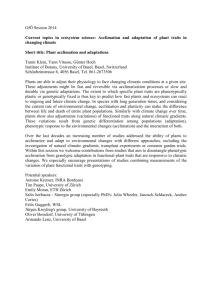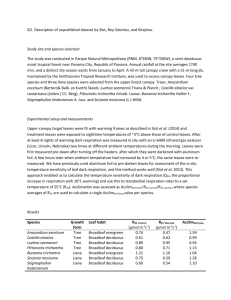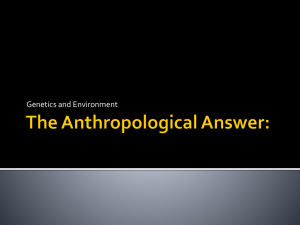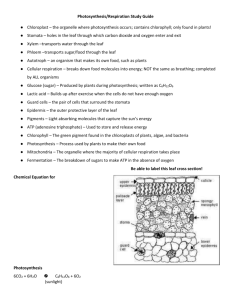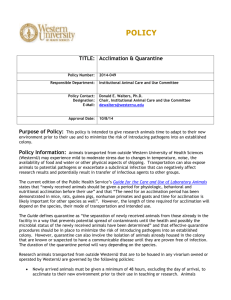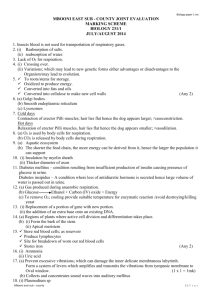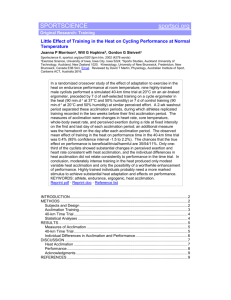gcb12563-sup-0002-DataS3
advertisement
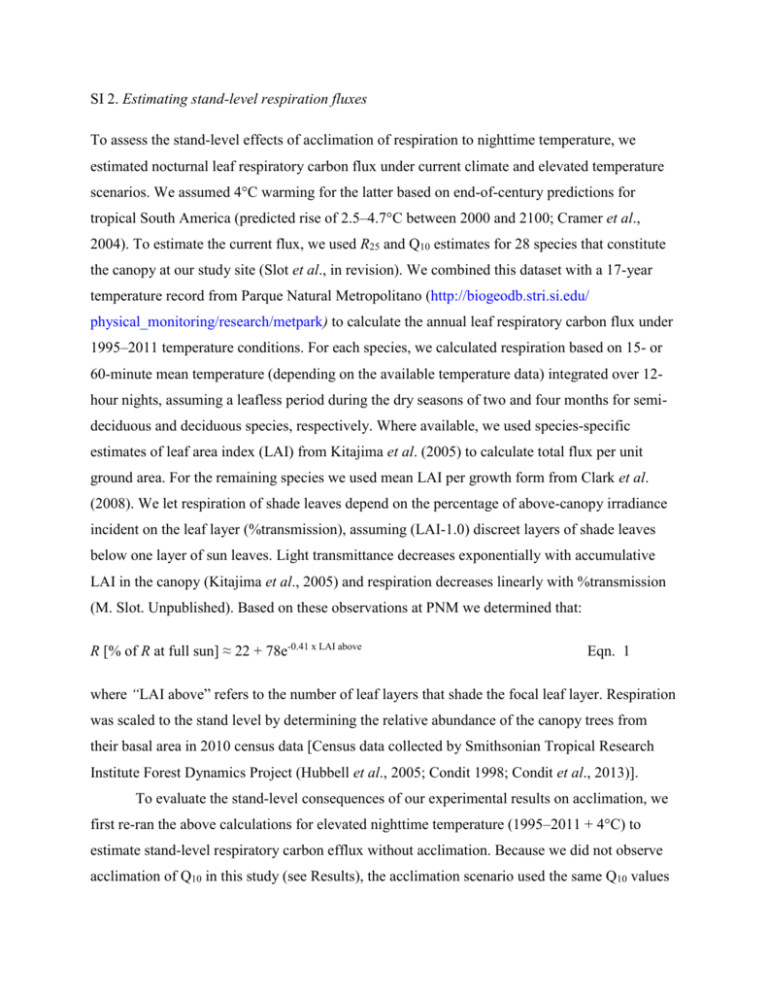
SI 2. Estimating stand-level respiration fluxes To assess the stand-level effects of acclimation of respiration to nighttime temperature, we estimated nocturnal leaf respiratory carbon flux under current climate and elevated temperature scenarios. We assumed 4°C warming for the latter based on end-of-century predictions for tropical South America (predicted rise of 2.5–4.7°C between 2000 and 2100; Cramer et al., 2004). To estimate the current flux, we used R25 and Q10 estimates for 28 species that constitute the canopy at our study site (Slot et al., in revision). We combined this dataset with a 17-year temperature record from Parque Natural Metropolitano (http://biogeodb.stri.si.edu/ physical_monitoring/research/metpark) to calculate the annual leaf respiratory carbon flux under 1995–2011 temperature conditions. For each species, we calculated respiration based on 15- or 60-minute mean temperature (depending on the available temperature data) integrated over 12hour nights, assuming a leafless period during the dry seasons of two and four months for semideciduous and deciduous species, respectively. Where available, we used species-specific estimates of leaf area index (LAI) from Kitajima et al. (2005) to calculate total flux per unit ground area. For the remaining species we used mean LAI per growth form from Clark et al. (2008). We let respiration of shade leaves depend on the percentage of above-canopy irradiance incident on the leaf layer (%transmission), assuming (LAI-1.0) discreet layers of shade leaves below one layer of sun leaves. Light transmittance decreases exponentially with accumulative LAI in the canopy (Kitajima et al., 2005) and respiration decreases linearly with %transmission (M. Slot. Unpublished). Based on these observations at PNM we determined that: R [% of R at full sun] ≈ 22 + 78e-0.41 x LAI above Eqn. 1 where “LAI above” refers to the number of leaf layers that shade the focal leaf layer. Respiration was scaled to the stand level by determining the relative abundance of the canopy trees from their basal area in 2010 census data [Census data collected by Smithsonian Tropical Research Institute Forest Dynamics Project (Hubbell et al., 2005; Condit 1998; Condit et al., 2013)]. To evaluate the stand-level consequences of our experimental results on acclimation, we first re-ran the above calculations for elevated nighttime temperature (1995–2011 + 4°C) to estimate stand-level respiratory carbon efflux without acclimation. Because we did not observe acclimation of Q10 in this study (see Results), the acclimation scenario used the same Q10 values used in the current-climate and no-acclimation scenarios. We let R25 acclimate to the running average of nighttime temperature of the preceding week when implementing the stand-level calculations according to observations in the warming experiment (see Results). We let all canopy species acclimate equally, as our results did not show significant acclimation differences among species and growth forms. Consequence of acclimation for estimated stand-level nighttime respiration fluxes We estimated a leaf respiratory nighttime carbon efflux of 5.5 Mg ha-1 yr-1 for this site (Fig. 1) based on 1995–2011 temperature data and assuming temperature to be the driver of temporal change in respiration. Increasing nighttime temperature by 4°C, not accounting for acclimation, increased the estimated flux to 7.6 Mg carbon ha-1 yr-1, an increase of 40%. Acclimation in which R25 decreased with average nighttime TLeaf of the preceding week (based on data shown in Fig. 4) resulted in an estimated annual nighttime carbon flux of 6.6 Mg ha-1. This represents a 14% reduction compared to 4°C warming without acclimation. Accounting for acclimation reduced the estimated temperature-induced increase in respiration with 4°C warming by 48%, from 2.1 to 1.1 Mg carbon ha-1 yr-1. Because acclimation did not result in perfect homeostatic maintenance of respiration rates, the calculated flux with 4°C warming was still 20% larger than the flux calculated from 1995–2011 temperatures. Figure 1. Estimated annual nighttime respiration at Parque Natural Metropolitano under ‘unwarmed’ temperature (1995–2011), and under 4°C warming with and without acclimation. Positive numbers (to the left of the 4°C warming bars) are percent increases in estimated nighttime fluxes relative to the current estimated nighttime flux. The negative number indicates the percent decrease in the flux relative to the no-acclimation scenario. Error bars represent the standard deviation of flux estimates based on inter-annual temperature variations. References Clark DB, Olivas PC, Oberbauer SF, Clark DA, Ryan MG (2008) First direct landscape-scale measurement of tropical rain forest Leaf Area Index, a key driver of global primary productivity. Ecology Letters, 11, 163–172. Condit R (1998) Tropical forest census plots. Berlin, Germany: Springer-Verlag, and Georgetown, USA: R. G. Landes Company. Condit R, Engelbrecht BMJ, Pino D, Pérez R, Turner BL (2013) Species distributions in response to individual soil nutrients and seasonal drought across a community of tropical trees. Proceedings of the National Academy of Sciences USA, 110, 5064–5068. Cramer W, Bondeau A, Schaphoff S, Lucht W, Smith B, Sitch S (2004) Tropical forests and the global carbon cycle: impacts of atmospheric carbon dioxide, climate change and rate of deforestation. Philosophical Transactions of the Royal Society of London Series B: Biological Sciences, 359, 331–343. Hubbell SP, Condit R, Foster RB (2005) Barro Colorado forest census plot data. [WWW document] URL https://ctfs.arnarb.harvard.edu/webatlas/datasets/bci [accessed 22 April 2013]. Kitajima K, Mulkey SS, Wright SJ (2005) Variation in crown light utilization characteristics among tropical canopy trees. Annals of Botany, 95, 535–547. Slot M, Rey-Sánchez C, Winter K, Kitajima K (2014) Trait-based scaling of temperaturedependent foliar respiration in a species-rich tropical forest canopy. Functional Ecology. In Press. doi:10.1111/1365-2435.12263
